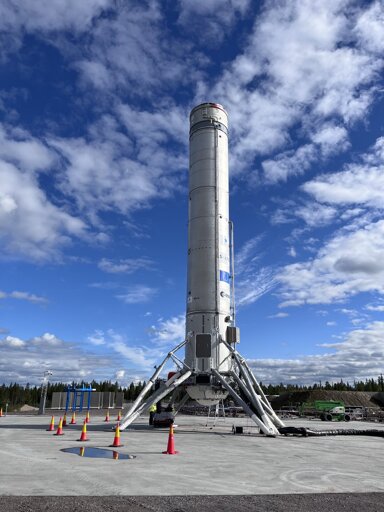In brief
- The first model of ESA’s reusable rocket demonstrator Themis is standing on its own legs at its launch pad in Kiruna, Sweden.
- Themis is set to be the first European demonstration of a full-scale vertical take-off and landing rocket element that uses cryogenic propulsion.
- This is the first time the rocket stage demonstrator has had its four legs installed, now the demonstrator is fully assembled.
I’m not familiar with what they’re doing here, but I’m guessing that for the purposes of just showing it taking off and then landing again or whatever, they don’t need to take it to space, so probably don’t need cowling to make it more aerodynamic.
This short article has a few more details on the timeline, specifically this graphic might be useful.
The first flight will be a small “hop”, where the engine will fire continuously but at varying ‘throttles’ – this in itself will be a first for Europe with the use of cryogenic propulsion. Flying up to 100 m on its first trip towards space, the hop-test is a significant milestone and allows engineers to focus on the critical landing and ground sequences for such a rocket.
So you are right T1H’s job will be to perform “hop” tests.
Thanks for doing the digging on it.
One other argument, aside from just lack of need and weight, for running it stripped down might also be that this may be risky — like, they may expect to lose a few of these along the path to ironing out bugs. If you don’t need to strap something to this, you’d probably rather not do so, if you’re liable to destroy a few.
I dunno how many SpaceX lost in their development process, but I’m sure there were some.
I am far from an expert and just looking this up myself since I am also interested, but it seems similar to SpaceX’s Grasshopper prototype, which apparently completed all its 8 launches/landings successfully. It’s a bit depressing to read that this was in 2012 over a decade ago, and Europe just now reaches this stage. Although catching up gives you the benefit of learning from what came before, so hopefully they’ll make rapid progress.
They did lose some Falcons, though, and it sounds like some of that was related to reusability development, albeit at a later stage. From that WP page:
In 2013, SpaceX moved to using their mainstream Falcon 9 vehicles for VTVL testing, in addition to their existing tests with flying test vehicles. In March 2013, SpaceX announced that, beginning with the first flight of the stretch version of the Falcon 9 launch vehicle—the sixth flight overall of Falcon 9 (then anticipated for summer 2013), every first stage would be instrumented and equipped as a controlled descent test vehicle.[68] SpaceX attempted numerous over-water landings, both over the sea, resulting in soft landings into the water, and onto specialized Autonomous Spaceport Drone Ships, barges modified to be landing platforms. None were completely successful.
SpaceX is a strange player in this field since they test their hardware to the limit. Here is an old video with thz falcon explosions https://www.youtube.com/watch?v=p9FzWPObsWA. It is 8 years old so does not contaign the starship tests.
On the other hand of the spectrum, you have all the national agencies that simulate a lot and test in controled environment. Did you see SaturnV explosions during development ? Or Artemis launch ? Ariane 5 only had 1 bug, Ariane 6 have a flowless start.
Just not the same test/development phylosohy.
Better late than never, so lets hope that from here on they double down and speed up development to catch up.
Also to state the obvious: it is too round on the top, it needs to be pointy




